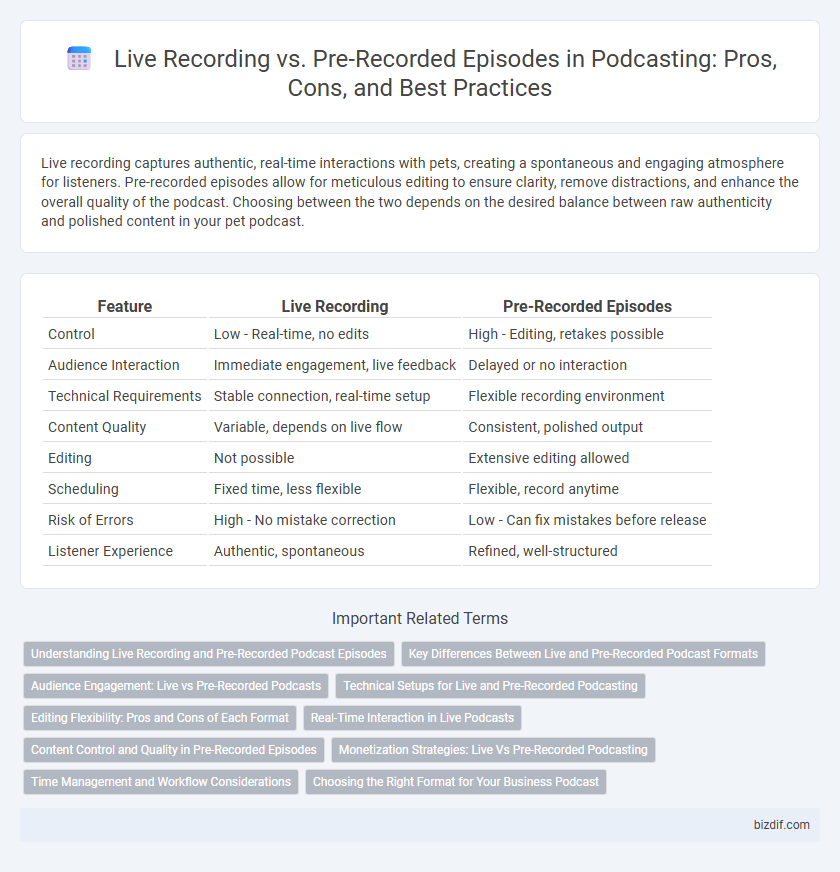Live recording captures authentic, real-time interactions with pets, creating a spontaneous and engaging atmosphere for listeners. Pre-recorded episodes allow for meticulous editing to ensure clarity, remove distractions, and enhance the overall quality of the podcast. Choosing between the two depends on the desired balance between raw authenticity and polished content in your pet podcast.
Table of Comparison
| Feature | Live Recording | Pre-Recorded Episodes |
|---|---|---|
| Control | Low - Real-time, no edits | High - Editing, retakes possible |
| Audience Interaction | Immediate engagement, live feedback | Delayed or no interaction |
| Technical Requirements | Stable connection, real-time setup | Flexible recording environment |
| Content Quality | Variable, depends on live flow | Consistent, polished output |
| Editing | Not possible | Extensive editing allowed |
| Scheduling | Fixed time, less flexible | Flexible, record anytime |
| Risk of Errors | High - No mistake correction | Low - Can fix mistakes before release |
| Listener Experience | Authentic, spontaneous | Refined, well-structured |
Understanding Live Recording and Pre-Recorded Podcast Episodes
Live recording captures spontaneous interactions and real-time audience engagement, creating an authentic and dynamic listening experience. Pre-recorded podcast episodes enable precise editing, sound quality control, and content refinement, ensuring polished and error-free delivery. Understanding these formats helps podcasters choose between immediacy and production quality based on their goals and target audience preferences.
Key Differences Between Live and Pre-Recorded Podcast Formats
Live podcast recordings offer real-time audience interaction and spontaneous content flow, enhancing listener engagement and authenticity. Pre-recorded episodes allow meticulous editing, sound quality control, and content refinement, resulting in polished and error-free broadcasts. Production flexibility and scheduling convenience distinguish pre-recorded formats, while live podcasts emphasize immediacy and dynamic listener participation.
Audience Engagement: Live vs Pre-Recorded Podcasts
Live podcasts foster real-time interaction, cultivating dynamic audience engagement through instant feedback, listener questions, and spontaneous content evolution. Pre-recorded episodes enable polished delivery and controlled quality, appealing to audiences who prefer well-edited, consistent content without interruptions. Both formats influence engagement metrics differently, with live shows boosting immediate participation and pre-recorded episodes sustaining long-term listenership.
Technical Setups for Live and Pre-Recorded Podcasting
Live podcasting requires robust audio interfaces, multi-channel mixers, and real-time streaming software like OBS Studio or Riverside.fm to manage on-the-fly sound adjustments and minimize latency for seamless audience interaction. Pre-recorded episodes benefit from advanced editing tools such as Adobe Audition or Audacity, enabling precise post-production enhancements like noise reduction, equalization, and content trimming for polished final output. Both setups typically utilize high-quality microphones, headphones, and backup recording systems to ensure consistent audio fidelity and prevent data loss.
Editing Flexibility: Pros and Cons of Each Format
Live podcast recording offers limited editing flexibility, requiring hosts to deliver content flawlessly in real-time, which enhances authenticity but risks uncorrected mistakes. Pre-recorded episodes provide extensive editing capabilities, allowing for the removal of errors, addition of sound effects, and seamless transitions to improve audio quality and listener experience. Choosing between formats depends on the balance between spontaneous interaction in live sessions and polished production in pre-recorded content.
Real-Time Interaction in Live Podcasts
Live podcast recordings foster real-time interaction by enabling immediate listener feedback and dynamic audience engagement, which enhances the authenticity and spontaneity of the content. This instant communication allows hosts to address questions, adjust topics, and create a more immersive experience that pre-recorded episodes cannot replicate. Real-time interaction in live podcasts cultivates a stronger community connection, boosting listener loyalty and promoting active participation.
Content Control and Quality in Pre-Recorded Episodes
Pre-recorded podcast episodes offer superior content control by allowing hosts to edit out mistakes, enhance audio quality, and structure the narrative for clarity and engagement. This controlled environment reduces background noise and technical glitches, ensuring a polished listening experience. Enhanced audio editing tools and post-production techniques contribute to consistently high-quality episodes, elevating listener satisfaction and professionalism.
Monetization Strategies: Live Vs Pre-Recorded Podcasting
Live podcast recordings generate real-time audience engagement that enhances sponsorship value through interactive ad placements and immediate listener feedback, driving higher conversion rates. Pre-recorded episodes allow for polished content and strategic ad insertions, enabling dynamic ad insertion and targeted monetization based on listener demographics. Both formats leverage unique monetization strategies, with live podcasts capitalizing on event-based exclusivity while pre-recorded shows benefit from scalable, on-demand advertising opportunities.
Time Management and Workflow Considerations
Live recording demands real-time coordination, requiring hosts and guests to be fully prepared, which can streamline workflow by eliminating post-production editing. Pre-recorded episodes offer flexible time management, allowing for multiple takes, detailed editing, and refinement to enhance audio quality and content clarity. Balancing these approaches helps podcasters optimize schedules, improve content delivery, and maintain consistent episode releases.
Choosing the Right Format for Your Business Podcast
Live recording fosters real-time audience engagement and authenticity, ideal for interactive business podcasts aiming to build strong community connections. Pre-recorded episodes offer enhanced control over audio quality and content editing, ensuring polished delivery and consistent messaging critical for professional branding. Selecting the appropriate format depends on your audience's preferences, content complexity, and the desired balance between spontaneity and production value.
live recording vs pre-recorded episodes Infographic

 bizdif.com
bizdif.com